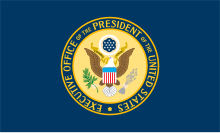
Back المكتب التنفيذي لرئيس الولايات المتحدة Arabic Oficina Executiva del Presidente de los Estaos Xuníos AST Изпълнителен офис на президента на САЩ Bulgarian نووسینگەی جێبەجێکاری سەرۆک کۆمار (ئەمریکا) CKB Swyddfa Weithredol Arlywydd yr Unol Daleithiau Welsh Executive Office of the President of the United States German Εκτελεστικό Γραφείο του Προέδρου των Ηνωμένων Πολιτειών Greek Prezidenta Administro de Usono Esperanto Oficina Ejecutiva del Presidente de los Estados Unidos Spanish دفتر اجرایی رئیسجمهور (آمریکا) Persian
This article needs additional citations for verification. (April 2017) |
 Seal of the Executive Office | |
 Flag of the Executive Office | |
| Agency overview | |
|---|---|
| Formed | July 1, 1939 |
| Jurisdiction | U.S. Federal Government |
| Headquarters | White House, Washington, D.C., U.S. |
| Employees | 1,800 (approximately) |
| Annual budget | $714 million[1] |
| Agency executive | |
| Website | whitehouse.gov/eop |
The Executive Office of the President of the United States (EOP) comprises the offices and agencies[2] that support the work of the president at the center of the executive branch of the United States federal government.[3] The office consists of several offices and agencies, such as the White House Office (the staff working closest with the president, including West Wing staff), the National Security Council, Homeland Security Council, Office of Management and Budget, Council of Economic Advisers, and others.[4] The Eisenhower Executive Office Building houses most staff.
The office is also referred to as a "permanent government", since many policy programs, and the people who are charged with implementing them, continue between presidential administrations.[5]
The civil servants who work in the Executive Office of the President are regarded as nonpartisan and politically neutral, so they are capable of providing objective and impartial advice.[5]
With the increase in technological and global advancement, the size of the White House staff has increased to include an array of policy experts responsible with managing various federal governmental functions and policy areas. As of 2015, it included approximately 1,800 positions,[6] most of which did not require confirmation from the U.S. Senate.
The office is overseen by the White House chief of staff. Since February 8, 2023, that position has been held by Jeff Zients, who was appointed by President Joe Biden.[7][8][9][10]
- ^ "FY 2017 Omnibus Summary – Financial Services and General Government Appropriations" (PDF). House Appropriations Committee. May 1, 2017. Archived (PDF) from the original on May 1, 2017. Retrieved May 1, 2017.
- ^ Harold C. Relyea (November 26, 2008). The Executive Office of the President: A Historical Overview (PDF) (Report). Washington, D.C.: Congressional Research Service. Retrieved April 17, 2018.
- ^ The USAGov program. "Executive Office of the President". USAGov. Retrieved February 10, 2024.
- ^ The White House. "Executive Office of the President". The White House. Retrieved February 10, 2024.
- ^ a b Mckeever, Robert J. (2014). A Brief Introduction to US Politics. doi:10.4324/9781315837260. ISBN 978-1315837260.
- ^ "The Executive Branch". whitehouse.gov. April 1, 2015. Retrieved March 5, 2021.
- ^ Hartnett, Cass. "Library Guides: United States Federal Government Resources: The Executive Office of the President". guides.lib.uw.edu. Retrieved January 5, 2019.
- ^ Trump, Donald J. (December 14, 2018). "I am pleased to announce that Mick Mulvaney, Director of the Office of Management & Budget, will be named Acting White House Chief of Staff, replacing General John Kelly, who has served our Country with distinction. Mick has done an outstanding job while in the Administration..." @realDonaldTrump. Retrieved January 5, 2019.
- ^ Swanson, Ian (December 14, 2018). "Trump names Mulvaney acting chief of staff". The Hill. Retrieved January 5, 2019.
- ^ O'Toole, Molly (December 30, 2018). "John F. Kelly says his tenure as Trump's chief of staff is best measured by what the president did not do". Los Angeles Times. Retrieved January 5, 2019.